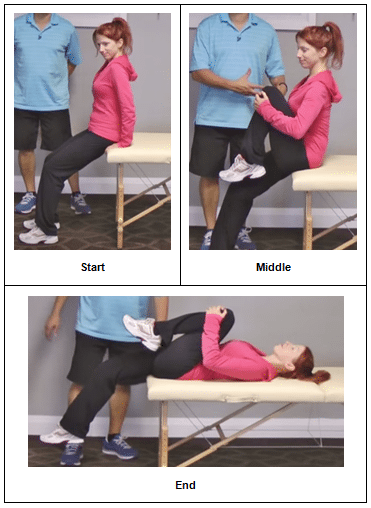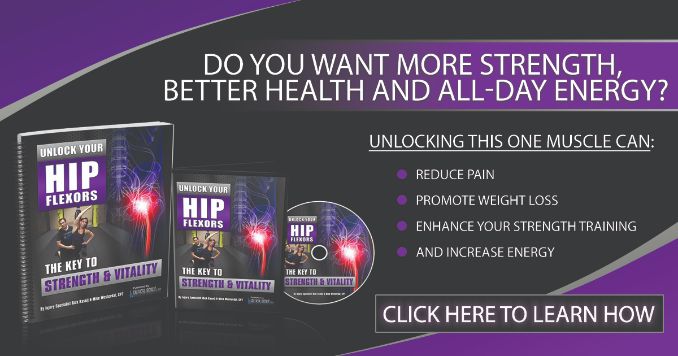
A hip flexor is a group of muscles in the front of the hip. Since these muscles are attached to the pelvis, they tilt it forward and lift it backward, depending on their contraction. The main purpose of this group of muscles is to lift and rotate your thigh toward your abdomen. This action occurs when you cross your legs or walk upstairs.
I wanted to go through an advanced hip flexor test in this video. Although this is more of an advanced test, it helps to identify if you have tight hip flexors. Most of us have tight hip flexors. Tight hip flexors can lead to many issues, such as back pain, bad posture, and poor mobility. One of the ways your hip flexors can become tight is from sitting.
As you probably know, most of us sit far too much, and tight hips are one of the many complications of too much sitting. When we sit, the muscles on the front side of our body can become shortened and tight. This includes the muscles of the chest and the hip flexors. If you have tight hip flexors, it is important to stretch them out regularly to avoid potential discomfort, pain, and injury.
CLICK HERE to watch the YouTube video.
Hip Joint
A joint is a connection between two or more bones. The hip joint is formed by the ball at the head of the thighbone (femur) and the socket in the pelvis. The femur and pelvis are surrounded by muscles, ligaments, and tendons, which help to support and move the joint.
The hip joint is a ball-and-socket type of joint. It allows for movement in all directions: up and down, forward and backward, side to side, and rotation of the thigh bone around a vertical axis.
Hip Flexor
Hip flexors are a group of muscles near the top of your thighs, which is the key to moving your lower body. They let to walk, kick, bend, and hinge on your hips. If your muscle is too tight or you make a sudden movement, your hip flexors can stretch or tear.
A hip flexor strain can be mildly uncomfortable or so serious that you have trouble walking, muscle spasms, and a lot of pain.
Stretching is the best way to increase your flexibility[¹]. It improves your posture, reduces muscle tension, and helps your body recover from injury. Stretching also lowers your risk for injuries, increases blood circulation, and keeps your joints limber, so they don’t get stiff as you age.
Examples of stretching:
- Standing stretch
- Active stretch
- Kneeling stretch
- Supine stretch
Thomas Test
The Thomas Test, also known as Iliacus Test or Iliopsoas Test, is used to measure the flexors’ flexibility, including the iliopsoas muscle group[²], the rectus femoris, pectineus, gracillis, as well as the tensor fascia latae, and the sartorius.
Sit on the edge of a table, preferably where your sit bones (or ischial tuberosities) are located. Take one of your knees and pull it up towards your chest. Rock back and let the other leg hang. In this position, you have locked up your pelvis in an upright posture.

Thomas Test
We are looking at three different things that could be happening:
- See if your hamstring or the back of your thigh is off the mat or the plinth.
Check if the bend in your knee is greater than 70 degrees, as that means tightness in the rectus femoris muscle. The hanging leg should be at 90 degrees. If it is less than 70 degrees from bent to straight, it shows tightness in the rectus femoris muscle.
Look at the knee and see how it aligns with the hip. If your knee is out to the side, that shows that you might have IT band tightness.
Give that advanced hip flexor test a go, and share your results.
You can use your phone to record it as you go through the movement from the side and the front, so you review your position. Or you can ask someone to test you and check those three different things quickly.
You can use a plinth, or if you are in a gym setting, you can use a bench to go through the test. If you are at home, you can use your table.
Make sure you have a stable table when you go through this exercise.
The importance of Thomas test is vital to everyone. It can help determine what muscles or joints are causing your pain and allow you to get the treatment that you need.
Final Word
Make sure to swing by
ExercisesForInjuries.com
Enter your injury or pain in the search bar on the top right of the screen. There’s a good chance I have an article, an interview, or a video to help you overcome injury or pain.
If you want to instantly release your hip flexors for more strength, better health, and all-day energy, click here to check out the Unlock Your Hip Flexors program.
References:
- Koslouski, J. B., Iovino, E. A., & Chafouleas, S. M. (2024). Feel Your Best Self: Insights from elementary teachers’ use in teaching emotion-focused coping strategies. Social and Emotional Learning Research Practice and Policy, 3, 100037. https://doi.org/10.1016/j.sel.2024.100037
- Lifshitz, L., Sela, S. B., Gal, N., Martin, R., & Klar, M. F. (2020). Iliopsoas The Hidden Muscle: Anatomy, diagnosis, and treatment. Current Sports Medicine Reports, 19(6), 235–243. https://doi.org/10.1249/jsr.0000000000000723

